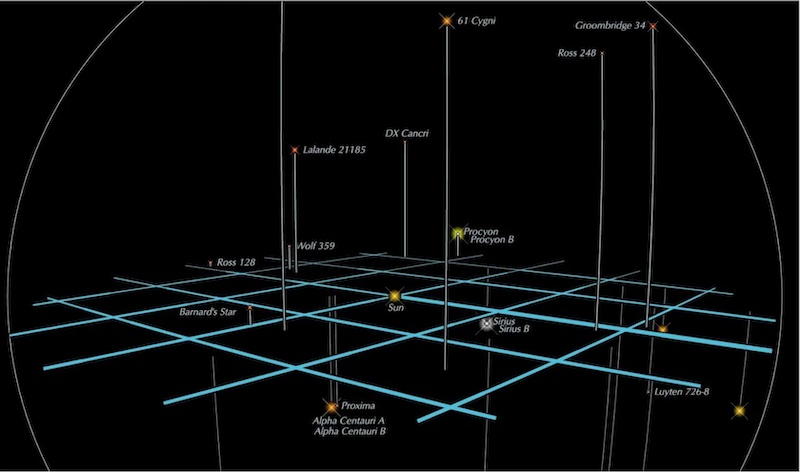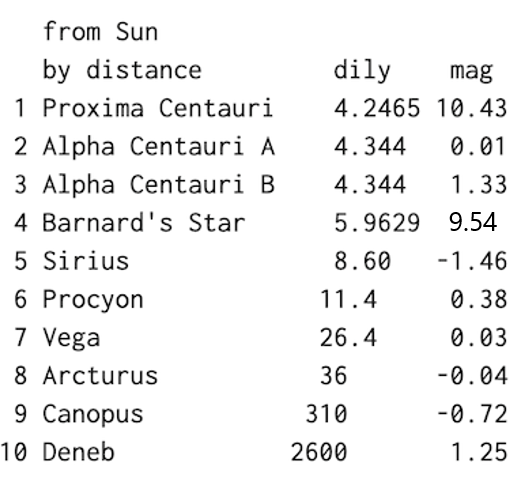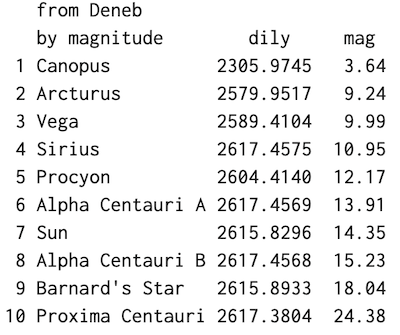
Beloved British astronomer Guy Ottewell originally published this piece as Allocenters on his website on June 11, 2023. Reprinted with permission. Edits by EarthSky.
How bright is our sun from Alpha Centauri?
The nearest star beyond the sun is Alpha Centauri. It’s an unfamiliar star for most of us because it is more than 60° south of the equator. In fact, it’s a triple star system, consisting of Alpha Centauri A and B – a binary pair, 4.34 light-years from us – plus a red dwarf star we call Proxima. Proxima is in a long orbit around the other two stars. And, in our current age, Proxima is the nearest star, at 4.25 light-years from us.
A question came from an EarthSky reader:
If Alpha Centauri is the third-brightest star in our sky, what is our sun’s ranking of brightness as seen from a hypothetical planet orbiting around, say, Alpha Centauri A?
I would assume Alpha Centauri B and Alpha Proxima would be significantly brighter than our sun due to their proximity to Alpha Centauri A.
Given our proximity to Alpha Centauri, I would guess we’re maybe fifth after Sirius and Canopus.
As a matter of fact, my cover picture story for Astronomical Calendar 1989 was called the View from Alpha Centauri. So, I thought I might have worked on this subject then. But I found recently I’d only partially done so.
Exploring other perspectives
So, we might call it allocentric, or other-centered. That’s distinct from geocentric, Earth-centered, and heliocentric, sun-centered. The word already exists, according to the Oxford English Dictionary, but with uses in medicine and psychology. I can use both ACEM for allocentric and Alpha Centauri in my programming algebra.
The question is: given the position (right ascension and declination), distance (light-years), and magnitudes (brightnesses) of stars Alpha Centauri A and B as seen from the sun, what is the distance and magnitude of B as seen from A?
It’s easy to see this algorithm – outline of the problem – and there’s a chain of equations for the steps in the procedure (finding, on the way, the rectangular coordinates from the polar ones and the absolute magnitudes from the apparent ones, and then back).
What is tangled is that it’s a multidimensional situation, in which numbers have to be stored in arrays so as to be sorted into order, the combinations growing exponentially with the number of stars being compared. Imagine, in my space diagram above, a sight-line from every star to every other star. A cat’s cradle, like the connections of neurons in a small brain!
This is mostly what has taken me 10 days of program-rewriting.
The nearest or brightest stars from our sun
We can’t consider all the stars in the sky – that would take a super-computer – so I considered some of the nearest, and some of the brightest. Here’s a list, with their distances in light-years and apparent magnitudes.
From the sun by distance (light-years) and magnitude

To clarify, there are other small stars nearer to us than Procyon; and others in the “top 20” of brightness above the extraordinary Deneb.
The same stars from Alpha Centauri A
Now let’s study them allocentrically. For example, their order of distance from Alpha Centauri A:
From Alpha Centauri A by distance (light-years) and magnitude

And the Centarocentric by brightness (magnitude)

Note: Compare Alpha Centauri B’s brightness with the apparent magnitude of the sun as seen from Earth: -26.8.
Seeing our sun from Sirius
Let’s try our brightest star as the allocenter:

The view from Deneb
Finally, let’s try the most distant of our bright stars as the allocenter:

Final thoughts
Finally, two remarks for the accuracy-minded: Don’t let it bother you that some of my numbers are given to ridiculous levels of precision; rounding them depending on their size is a lot more trouble. And you may find different recent figures for the distance or magnitude of some of the stars. They shouldn’t make much difference.
Comparing the lists, you can see that I’m going to take a rest from cogitation. Let us know if you can make any generalization about the changes in these orders of brightness from different viewpoints.
Bottom line: How bright is our sun from other stars? Famed astronomer Guy Ottewell explores the perspective from Alpha Centauri A, Sirius and Deneb.











